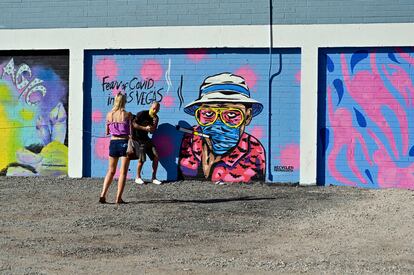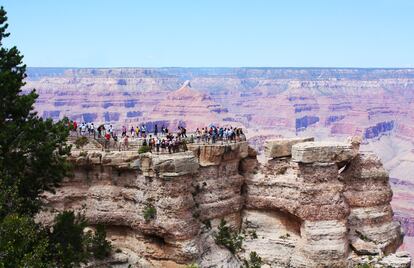The first shocks come when you see appearing, among the dust, aridity and nothingness of the Mojave Desert, a luminous mass, full of multicolored skyscrapers. As if that city were a sun and it was dawning. You get closer and the architecture of ostentation grows: the mountains of money transformed into various things, enormous and very striking. Then the shock wave hits you. Afterwards, the waste of water and all kinds of resources leaves your heart and head shaking, immersed in a sensory earthquake. Because this is Nevada, the driest state in the entire United States. Things get worse when you realize that these resources are sucked out of the Colorado River, already almost reduced to a narrow mass of soaking mud. Although there are studies that say that this is a sustainable circuit, that sewage and even the vomit of those who put themselves at the back of everything are used.
What really slaps your head internally is seeing that, on one side, the Grand Canyon of the Colorado, a diamond that was created alone, long before humans arrived, is now dying, while on the other side the artificial Versailles pop of America. That’s how Tom Wolfe named Las Vegas, and he was very right.
Arriving by plane, it is quite an experience to see how that geyser of excessive luxury emerges, rising in spirals towards the sky, shining with neons and creating a vape of grandeur. Unlike Versailles, there is nothing really aristocratic behind those vapors. It is the complete opposite of aristocracy, although many of those who created it – mostly gangsters – had – and have – quite aristocratic aspirations.
From the airport, jumping from one bus to another to get to the hotel, a passenger who seems to be originally from Las Vegas asks me where I am from. When I answer him, he tells me that last year he was in Barcelona, at the Bruce Springsteen concert, that he liked that everything was so cheap, and that, since he sees me a little lost, he recommends that I get off at the last stop and I got on The Deuce. It is a public bus, double decker, and costs $8 for 24 hours. Explore the city, but especially the Las Vegas Strip, just over six kilometers full of hotels.resort —with a casino, bars, restaurants and chapels to get married inside—, like the legendary Caesars Palace, or the Bellagio, with around 1,000 fountains that perform spectacular dances many times a day. A little further on, the sumptuousness takes shape with a replica of the Eiffel Tower, another of the Statue of Liberty and part of Manhattan, and all kinds of impressive things. It’s a bit like: “I’m going to turn my body into an amusement park/ I’m going to convince your parents to let you come play/ I’m going to turn my respiratory system into a network of giant, colorful slides.” that Óscar García Sierra writes in his collection of poems Houston, I’m the problem.
Bulletin
The best travel recommendations, every week in your inbox
RECEIVE THEM
On that journey it is almost schizophrenic to see giant advertisements with Jesus in very clear letters, or remembering that “sin has consequences, repent”, next to others that almost shout at you to get addicted and consume everything that your body and your wallet can handle. . It is not weird. The first to settle in this city in the mid-1800s, after expelling the local indigenous population, were the Mormons, a fairly strict religious movement. Somewhat later, communities of miners who loved gambling and betting settled in. The so-called “sin city” already had from its origin that bipolarity of angel and demon, that holy counterpart that has never wanted to disappear. Again, as García Sierra writes: “I have a dark side that I use to touch myself thinking about the light.”
Sitting on this double-decker bus, at the top and in the front row to enjoy the views through the window, I tour the entire Las Vegas Strip. Then I pass by the Arts District —the most part hipster and one of the most interesting currently—and I get off near Downtown and Fremont Street, the oldest area of destruction in the city and a little more authentic and affordable. In that area, in the 1950s and 1960s, it was common to see the large dust mushrooms left behind by nuclear explosions in the background. In fact, some hotels used it as a tourist attraction, there were “atomic” cocktails that were sold in bars and a beauty contest was even created with that theme: Miss Atomic Bomb. This is how, after the Mormons, and after the gangsters, Las Vegas received one of the great economic boosts: with the Nevada Test Site. A little more than 90 kilometers away from the city, in the middle of the desert, nuclear tests were carried out for decades—from the 1940s to almost the 2000s—expelling the Native Americans from their home and without taking much into account. the subsequent consequences of the radiation for the inhabitants for miles around, who years later died of cancer.

Religion, atomic bomb, mafia, addictive consumerism and obscene capitalism. Stirring and shaking all of that and you get Las Vegas. There are very interesting museums of all this, although it is necessary to travel with a well-prepared pocket, because tickets cost between 25 and 60 euros.
Now some say it is the brightest place on the planet, clearly visible from space. And it could be true, because it is the epicenter of light pollution and many other pollutions, as well as one of the cities that has grown the fastest in the last 20 years and that is warming—and drying—the fastest in the United States. But all these contradictions are the clear reflection of humanity, of this new era of hyperreality, of building no longer on what exists, but on an illusion of the illusion. That’s why it’s so worth visiting.
If you can, you have to fly over the G
rand Canyon
Elling Halvorson was commissioned in the sixties to carry out a project that was somewhat challenging for the time. He had to build an oil pipeline across the Grand Canyon. It occurred to Halvorson that he could use helicopters to transport the huge sections of that tube over the rocky, steep terrain. So, every day, the workers made the journey flying over this wonder of nature. They had such a good time and liked that ride so much that the builder thought he could turn it into a good tourist business. This is how, in 1965, he founded Papillonone of the few helicopter tour companies from Las Vegas to the Grand Canyon that has survived the ravages of the covid crisis.

It is not for all budgets. The tours The cheapest are around 150 euros per person, and they go up from there. But if you can, the trip is very worth it. They pick you up near your hotel and then the flight lasts about 90 minutes. You get on a helicopter that can fit five travelers and the pilot. They play epic music when you take off, dude The Lord of the rings, and then you fly over the city with the casino buildings and it seems like you have gotten into the game of Monopoly. Then you begin to see the desert, very long pieces of land and brown and ocher rocks, until you reach Lake Mead, the largest body of water in the country built by humans. It is nourished by the Colorado River. This lake supplies water not only to Nevada, but also to other states and even parts of northern Mexico. Then you advance over semi-mountainous areas until the Grand Canyon appears and you realize that this world is incredible for being able to create such beauty. You can look anywhere, towards infinity, and everything is spectacular.

But if flying in a helicopter is out of your budget, there are also bus excursions that bring you closer to this natural wonder and leave you time to walk around and see some of its corners. The excursion takes longer, almost a whole day, and you have to get up quite early, but it is worth doing this trip visiting both extremes, Las Vegas and the Grand Canyon, because in some way it balances us and makes us discover both points at once. most fascinating way.
Subscribe here to The Traveler newsletter and find inspiration for your next trips in our accounts Facebook, x and instagram.
#Las #Vegas #Grand #Canyon #urban #debauchery #amazing #nature


